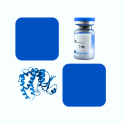
- Remove this product from my favorite's list.
- Add this product to my list of favorites.
Products
Newsletter
 |  |  |  |  |  |

Background
CD40 ligand is also known as CD40L, CD154, TNFSF5 and T-cell antigen Gp39, is a single-pass type I I membrane protein which belongs to the TNF superfamily of molecules. CD40 ligand is expressed predominantly on activated CD4+ T lymphocytes, and also found in other types of cells, including platelets, mast cells, macrophages, basophils, NK cells, B lymphocytes, as well as non-haematopoietic cells (smooth muscle cells, endothelial cells, and epithelial cells). Although all monomeric, dimeric and trimeric forms of soluble CD40 ligand can bind to CD40, the trimeric form of soluble CD40 ligand has the most potent biological activity through oligomerization of cell surface CD40, a common feature of TNF receptor family members. CD40 ligand binds to CD40 on antigen-presenting cells (APC), which leads to many effects depending on the target cell type. In general, CD40 ligand plays the role of a costimulatory molecule and induces activation in APC in association with T cell receptor stimulation by MHC molecules on the APC. In total CD40 ligand has three binding partners: CD40, α5β1 integrin and αIIbβ3. CD40 ligand regulates B cell function by engaging CD40 on the B cell surface. A defect in this gene results in an inability to undergo immunoglobulin class switch and is associated with hyper IgM syndrome.
Source
Recombinant Mouse CD40 Ligand, Fc Tag (CDL-M526x) is expressed from human 293 cells (HEK293). It contains AA Gly 115 - Leu 260 (Accession # P27548-1).
Molecular Characterization
This protein carries a human IgG1 Fc tag at the N-terminus
The protein has a calculated MW of 42.9 kDa. The protein migrates as 52 kDa under reducing (R) condition, and 90-116 kDa under non-reducing (NR) condition (SDS-PAGE) due to glycosylation.
Endotoxin
Less than 1.0 EU per μg by the LAL method.
Purity
>95% as determined by SDS-PAGE.
Formulation
Lyophilized from 0.22 μm filtered solution in Tris with Glycine, Arginine and NaCl, pH7.5 with trehalose as protectant.
Reconstitution
Please see Certificate of Analysis for specific instructions.
For best performance, we strongly recommend you to follow the reconstitution protocol provided in the CoA.
Storage
For long term storage, the product should be stored at lyophilized state at -20°C or lower.
Please avoid repeated freeze-thaw cycles.
This product is stable after storage at:
-20°C to -70°C for 12 months in lyophilized state;
-70°C for 3 months under sterile conditions after reconstitution.
Bioactivity
Please refer to product data sheet.
(1) "Monophosphoryl Lipid A-based Adjuvant to Promote the Immunogenicity of Multivalent Meningococcal Polysaccharide Conjugate Vaccines"
Alugupalli
Immunohorizons (2024) 8 (4), 317-325
(2) "Modelling Annihilation Properties of Positronium Confined in Nanoporous Materials: A Review"
Castelli, Consolati
Int J Mol Sci (2024) 25 (7)
(3) "A Prospective Observational Study Analyzing the Diagnostic Value of Hepcidin-25 for Anemia in Patients with Inflammatory Bowel Diseases"
Petrović, Tarabar, Ćujić et al
Int J Mol Sci (2024) 25 (7)
Showing 1-3 of 8363 papers.
Follow us